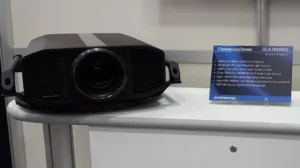CEDIA 2016 was the venue for the U.S. launch of the company’s new 4K native (4096×2160) projector using its D-ILA LCOS imagers. We had a full report on this projector based upon its IFA launch for Europe (JVC Releases Laser Phosphor Projectors), so we will summarize the news and demos at CEDIA below.
The projector is called the DLA-Z1 in Europe and the DLA-RS4500 for the custom install market in the U.S. Current home theater products have been 1080p or near 4K resolution using e-shifting technology. The price point is $35K which is a lot more than JVC’s 4K e-shift projectors. But JVC was one of the first to offer a native 4K resolution projector when they launched the RS4000 at CEDIA 2009 for $175K, so by comparison, the price is quite good.
The projector has HDR support by loading in the PQ EOTF to support HDR10 content as well as the Hybrid Log Gamma (HLG) EOTF for live content. JVC did demos of HLG content at IFA but not at CEDIA. The HDMI standard needs to be updated to allow for a flag to signal the content is encoded with the HLG EOTF. This is expected later this fall in the HDMI 2.1 specification. The projector can apparently be updated to support this revision of the HDMI interface. It will ship with an HDMI 2.0b interface, which adds more audio support and an 8-bit HDR option to the features available in HDMI 2.0a.
As we noted in our IFA write up, JVC has moved to a non-rotating phosphor substrate with a heat pipe and air cooling. This improves reliability and reduces noise. Lifetime remains the industry standard of 20K hours to 50% of initial brightness. Lumen output is 3000 lumens, but not in DCI-P3 mode, where it shrinks to around 1600-1800 lumens. The phosphors are driven with 48 blue lasers in 6 banks. Color gamut is said to be 100% of P3 and 80% of BT.2020.
THX certification is underway, but will be delayed as THX is focusing on higher volume (and royalty producing) flat panel TVs first.
In the JVC booth at CEDIA, native 4K content was shown on a 130” StudioTek 130 screen from Stewart Filmscreen with content delivered from a BlackMagic media player. Footage from MammothHD and the film “Lucy” were shown with great effect. Images were crisp with nice black levels and rich colors. – CC

